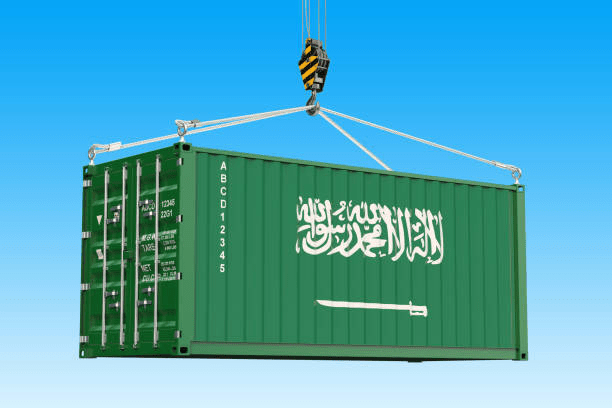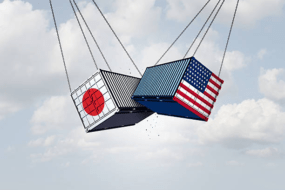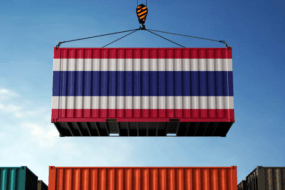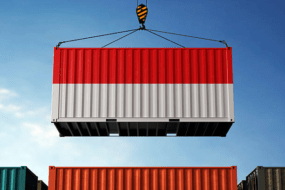- Home
- Trade News
- Saudi Arabia Exports of Crude ...

Saudi Arabia, long established as the largest exporter of crude oil, now finds itself at a turning point. Crude shipments are slipping, yet diesel exports are climbing. This unexpected reversal raises questions about the kingdom’s strategy in a rapidly shifting international trade landscape.
What appears at first to be a routine statistical fluctuation could signal deeper changes in global demand, regional positioning, and the future direction of the Middle East’s most influential economy.
Diesel and Gasoline Exports Signal a New Market Direction
Saudi Arabia’s oil trade is entering a new phase of mixed signals. According to the Joint Organisations Data Initiative (JODI), crude exports climbed slightly in May to 6.19 million barrels per day, up 1.19 percent from last year, supported by a rise in overall production to 9.18 million bpd.
This increase aligns with OPEC+’s ongoing strategy to gradually unwind the voluntary cuts of previous years, with Saudi Arabia taking a leading role in dialling production upwards. Refined oil exports jumped 12.12 percent, driven by a 25 percent surge in motor and aviation gasoline shipments.
Gasoline and diesel remained the largest share of refined exports, accounting for nearly half of the total despite recording a modest decline. Meanwhile, fuel oil also dipped, reflecting uneven trends within the refined category.
Domestically, refinery crude output fell by 7.64 percent, while direct crude burn for power generation rose 23 percent, fuelled by population growth and higher energy demand across the Kingdom.
What Are the Dominant Exports of Saudi Arabia?
The dominant exports of Saudi Arabia are crude oil, refined petroleum, and petrochemicals. While crude oil remains the foundation of its economy and accounts for most of its export revenue, the country is rapidly expanding its non-oil sectors. This includes a significant increase in the export of refined products like diesel and petrochemicals.
For decades, Saudi Arabia has been the world’s largest crude exporter. However, in line with its Vision 2030 strategy, the kingdom is pursuing a dual approach: maintaining its dominant position in crude oil while expanding its capacity to export higher-value refined products.
This evolution is not just about a number shift. It reflects how Saudi Arabia strategically adapts to global market trends. The Saudi government and its state-owned company, Aramco, are proactively diversifying their export portfolio to ensure the economy remains resilient in a changing global energy landscape.
What Are Petroleum Oils and Oils Obtained From Bituminous Minerals?
Petroleum oils and oils obtained from bituminous minerals refer to crude oil and its refined products. Crude oil and refined products are the cornerstone of Saudi Arabia’s exports, contributing the highest percentage of its overall trade.
In simple terms, this category includes:
- Crude oil (unrefined hydrocarbons)
- Refined fuels (such as diesel, jet fuel, and gasoline)
- Residual by-products are used in industries like plastics and fertilizers
The story is that Saudi Arabia is pursuing a dual strategy. It is maintaining its position as a leading crude oil exporter while simultaneously ramping up its exports of higher-value refined products like diesel.
Why Are Petrochemicals Important for Saudi Arabia’s Exports?
Saudi Arabia’s economy is heavily dependent on petroleum and related industries. The country holds the second-largest proven oil reserves in the world, about 17 percent of the global supply, with most of these reserves located in its eastern region, from the borders of Iraq and Kuwait into the Rubʿ al-Khali desert.
Petrochemicals are an important pillar of the country’s export strategy. They represent a structural part of the economy that helps reduce reliance on volatile crude prices. Petrochemicals were valued at over $20 billion in export revenues in the most recent year, with strong Asian buyers, including Malaysia, Singapore, and India.
Petrochemicals also play a crucial role in Vision 2030. This strategy allows Riyadh to gradually reposition itself as more than just a crude oil supplier. Instead, Saudi Arabia aims to become a reliable global supplier of industrial inputs, providing essential materials for nations developing advanced industries.
How Is Saudi Arabia Diversifying Beyond Oil Exports?
Saudi Arabia is actively diversifying its economy beyond crude oil through a strategic plan known as Vision 2030. This plan focuses on growing a wide range of non-oil exports and developing new industries.
While oil is the top export product globally, Saudi Arabia is the biggest exporter, with Russia and Canada coming next. The most important non-oil export categories are petrochemicals and plastics, which leverage the country’s vast hydrocarbon resources to create higher-value goods.
In addition to petrochemicals, Saudi Arabia is expanding into new sectors, including:
- Mining and Metals: The country is investing heavily in becoming a major producer and exporter of metals such as aluminium and copper.
- Digital Services and Technology: The government invests in digital infrastructure, smart cities (like NEOM), and artificial intelligence to create a knowledge-based economy.
- Logistics and Transportation: Leveraging its strategic location, Saudi Arabia aims to become a major global logistics hub, with massive investments in ports, airports, and rail networks.
- Tourism and Entertainment: The country is building “giga-projects” and investing in entertainment to attract millions of tourists and turn tourism into a key non-oil revenue stream.
What Are Saudi Arabia’s Non-Oil Exports?
Saudi Arabia’s non-oil exports include:
- Plastics and fertilizers
- Organic chemicals
- Metals such as iron, steel, copper, and aluminium
- Precious stones and jewellery
- Manufactured goods like boats and ships
While these categories still comprise a smaller portion of total exports, their share steadily increases. The key question is whether this growth can provide economic stability as the country’s reliance on volatile oil prices decreases.
How Does Vision 2030 Support Diversification?
Vision 2030 supports diversification by actively promoting non-oil industries and services. Its ambitious target is to raise the share of non-oil exports to 50 percent of non-oil GDP by 2030.
This involves encouraging investment in high-value sectors such as petrochemicals (plastics and fertilizers), machinery, and consumer goods. The plan also emphasises strategic partnerships with countries and international companies to attract foreign direct investment and expertise.
While this agenda has shown significant progress in developing promising sectors, critics point out that the timeline is highly ambitious. Oil continues to be the dominant driver of government revenues.
Until non-oil exports grow fast enough to provide a substantial and stable alternative, the kingdom’s economy will remain exposed to crude price volatility.
What Other Notable Exports Come From Saudi Arabia?
Beyond crude and refined fuels, Saudi Arabia exports a growing range of non-oil goods. These include intermediate goods like plastics and fertilizers, and capital goods such as machinery and ships. While these sectors are currently smaller in scale than oil, they are vital for building a resilient economy less exposed to crude price volatility.
These diverse export categories reveal Riyadh’s intent to develop industries that can sustain the economy in the long term, even as global energy demand evolves. This strategic approach signals to trade partners that Saudi Arabia is repositioning itself as a reliable supplier of various industrial and consumer products, not solely as the origin country for crude.
What Are Saudi Arabia’s Intermediate Goods Exports?
Saudi Arabia’s intermediate goods exports are mainly plastics, organic chemicals, and fertilizers. These products are crucial to manufacturing across Asia, especially in major markets like India, Malaysia, and Singapore.
In 2024, plastics exports alone were valued at approximately $18.63 billion, demonstrating their growing importance as a percentage of total exports. This strategic focus matters because these goods are essential for global supply chains, giving Saudi Arabia a vital role in packaging and automotive production.
This shift from exporting raw crude to processed intermediate goods is a key part of the country’s economic diversification strategy, building a more resilient economy by capturing more value from its hydrocarbon resources.
What Consumer Goods Does Saudi Arabia Export?
Saudi Arabia exports a growing, though still modest, range of consumer goods, including precious stones, jewellery, and various chemical-based products.
While these categories are small compared to the country’s dominant oil exports, they are significant within regional trade, especially with neighbouring countries like the United Arab Emirates, Oman, and Jordan.
Exporting consumer goods is a strategic signal of Saudi Arabia’s ambition to develop an economic profile beyond hydrocarbons. It demonstrates a deliberate effort to create a more diverse and resilient economy.
The primary challenge is to scale these emerging sectors to a point where they can generate a significant portion of the country’s export revenue, thereby reducing its long-term reliance on oil price fluctuations.
What Capital Goods Does Saudi Arabia Export?
Saudi Arabia exports a limited but growing range of capital goods, including machinery, electrical machinery, and steel products.
The country also exports ships and boats from its developing shipbuilding industry. While these exports are still a very small part of the country’s overall trade portfolio (around 3 percent of total exports), they are strategically important.
This expansion into manufactured goods reflects the government’s ambition to transform the kingdom into a supplier of higher-value industrial products, moving beyond its traditional role as a crude oil exporter.
Who Are the Key Export Partners of Saudi Arabia?
China, India, the United Arab Emirates, and South Korea anchor Saudi Arabia’s export map. These countries are central to Riyadh’s trade balance for crude oil and non-oil exports, including petrochemicals and refined fuels.
The geography of this trade map tells us that while neighbouring countries like Bahrain and Egypt are important, real growth is coming from Asia, where demand for crude and refined products continues to rise.
Why Is China a Crucial Partner for Saudi Arabia Exports?
China is the most important buyer of Saudi Arabia’s exports, importing vast quantities of crude oil, refined fuels, and organic chemicals. According to recent data from March 2025, China accounted for approximately 15.5 percent of Saudi exports, making it the primary destination for the Kingdom’s goods.
This relationship is vital to both nations. Saudi Arabia relies on China not just for significant revenues but also for long-term business security. China’s massive and growing economy, for its part, depends on Saudi Arabia to meet its energy needs.
How Important Is India for Saudi Arabia’s Trade?
India is a key partner for crude oil and refined fuel imports. Data from May 2025 shows that India received 8.9 percent of total Saudi exports. While crude oil remains the dominant export to India, shipments of refined products like diesel have been steadily increasing.
This reflects Saudi Arabia’s strategic decision to sell higher-value products alongside its crude oil, not a replacement for one or the other.
Beyond being a major customer, India shares strong business ties with Saudi Arabia in the fertilizers, plastics, and services sectors. This cooperation highlights Saudi Arabia’s successful efforts to diversify its export portfolio and strengthen its influence in the crucial South Asian market.
What Role Does the United Arab Emirates Play in Saudi Exports?
The United Arab Emirates plays a dual role: it is a direct buyer of Saudi goods and a crucial re-export hub. The UAE is the second-largest destination for Saudi exports, receiving about 11.2 percent of total exports in May 2025.
Products such as petrochemicals, plastics, and fertilizers are sent to the UAE, with a significant portion then re-exported through its advanced logistics network to wider international markets in Asia, Europe, and beyond.
This makes the UAE an indispensable partner. Its role as a commercial gateway for Saudi goods provides a vital connection to global supply chains, solidifying its importance beyond direct trade volumes.
Why Is South Korea a Significant Destination for Saudi Exports?
South Korea is a major destination for Saudi crude oil, refined fuels, and petrochemicals. In 2024, it was among the top 10 destinations for Saudi exports, accounting for a significant share and underlining its crucial role in Asia’s energy security.
The partnership with South Korea is strategic for both countries. Riyadh secures stable buyers for its oil and higher-value non-oil products.
In contrast, Seoul secures the critical resources it needs for its advanced manufacturing industries, from chemicals and electronics to heavy machinery. This relationship is a prime example of Saudi Arabia’s strategy to become integral to global industrial supply chains.
Why Is Digital Trade Becoming Important for Saudi Arabia?
Digital trade is becoming critically important for Saudi Arabia as it supports the Kingdom’s economic diversification efforts under Vision 2030, reducing its reliance on oil and gas.
The rapid growth of e-commerce, fintech, and various digital services creates new export opportunities while enhancing supply chain efficiency and international competitiveness.
Saudi Arabia has invested extensively in next-generation digital infrastructure, including widespread 5G networks, AI, and cloud computing facilities, to become a global hub for innovation and cross-border digital services.
For example, the National Transformation Program, a key part of Vision 2030, has set ambitious targets to develop the digital economy. These include raising the ICT sector’s contribution to GDP and increasing its overall economic share.
This strategy, alongside the push for smart logistics and online retail, ensures Saudi Arabia’s long-term trade relevance goes far beyond its traditional exports.
FAQs
To round things off, here are some quick answers to people’s most common questions about Saudi Arabia’s shifting export trends.
1. What Is Saudi Arabia’s Largest Export?
Saudi Arabia’s largest export is crude oil. Despite significant efforts to diversify the economy, crude oil remains the primary source of export revenues and the backbone of the Kingdom’s economy.
2. Why Are Saudi Arabia’s Diesel Exports Rising?
Saudi Arabia’s diesel exports are rising due to a strategic expansion of its refining capacity and growing global demand for refined fuels. The country captures additional profits and adds value to its exports by processing more crude oil into high-value products like diesel.
3. How Important Is China for Saudi Arabia’s Exports?
China is Saudi Arabia’s most important export partner because it is the world’s largest consumer of crude oil and a key buyer of refined products and petrochemicals. This relationship provides Riyadh with steady, large-scale demand for its energy exports.
Beyond hydrocarbons, both nations are expanding cooperation in technology, infrastructure, and digital trade, strengthening their long-term strategic partnership.
Conclusion: Diesel Momentum and the Road Ahead for Saudi Arabia’s Exports
Saudi Arabia is at a crossroads. The decline in crude oil exports highlights the vulnerabilities of a hydrocarbon-based economy, yet the rise of diesel and refined product exports offers new profits. While the gov works to develop non-oil industries under Vision 2030, crude and petroleum still anchor the GDP.
At TradeDataPro, we continue to track these market shifts, whether it’s the decline in crude flows, the unexpected strength of diesel, or the emerging role of non-oil industries. Visit us to explore detailed trade data, statistics, and insights that can help your company navigate such transitions for timely analysis of global exports, imports, and evolving markets.








